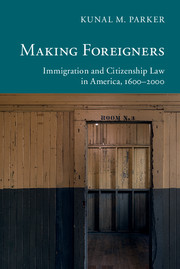Book contents
- Frontmatter
- Contents
- Preface and Acknowledgments
- 1 Introduction
- 2 Foreigners and Borders in British North America
- 3 Logics of Revolution
- 4 Blacks, Indians, and Other Aliens in Antebellum America
- 5 The Rise of the Federal Immigration Order
- 6 Closing the Gates in the Early Twentieth Century
- 7 A Rights Revolution?
- 8 Conclusion and Coda
- Bibliographic Essay
- Index
2 - Foreigners and Borders in British North America
Published online by Cambridge University Press: 05 September 2015
- Frontmatter
- Contents
- Preface and Acknowledgments
- 1 Introduction
- 2 Foreigners and Borders in British North America
- 3 Logics of Revolution
- 4 Blacks, Indians, and Other Aliens in Antebellum America
- 5 The Rise of the Federal Immigration Order
- 6 Closing the Gates in the Early Twentieth Century
- 7 A Rights Revolution?
- 8 Conclusion and Coda
- Bibliographic Essay
- Index
Summary
Introduction
Between the establishment of the first English settlements and the American Revolution, the North American colonies grew from tiny, fragile communities that could barely sustain themselves into diverse societies that collectively numbered multiple millions. Over the same period, they developed into major exporters of cash crops, significant markets for British exports, and challengers to the imperial trading system. This growth and development rested upon the accomplishment of various goals: clearing indigenous groups; settling lands; instituting systems of forced labor; and regulating nascent communities. Migration played a critical role. Approximately 900,000 people crossed the Atlantic during this period, almost three-fourths of them arriving in unfree statuses.
The pervasiveness of unfreedom in colonial era migration entails challenges for the historian seeking to identify an “immigration and citizenship law” for the period. Colonists on both sides of the Atlantic imagined, organized, and regulated membership, territory, and movement in ways very different from ours.
Borders were everywhere: between Great Britain and its overseas colonies; between British possessions and those of other European powers; between British possessions and Indian country; between the mainland colonies; between counties and towns within individual colonies; and within counties and towns themselves. These borders were enforced against individuals in different ways depending on their legal status: British subject, naturalized subject, denizen, alien, servant, redemptioner, convict, married woman, pauper, slave, free white, free black, Indian. The relationship between borders and statuses was complex. In some cases, legal status directly governed an individual's right to cross or remain within borders. In other cases, legal status worked more obliquely. Insofar as it shaped the distribution and content of political and social membership, it ended up determining rights to presence and movement. Communities were more likely to restrict, restrain, exclude, or remove individuals slotted into inferior legal statuses. By contrast, they were more likely to welcome as equals individuals granted superior legal statuses. This profusion of legal statuses and territorial borders makes visible a few signal interrelated features of the seventeenth- and eighteenth-century “immigration and citizenship regime” that are worth setting forth.
- Type
- Chapter
- Information
- Making ForeignersImmigration and Citizenship Law in America, 1600–2000, pp. 22 - 49Publisher: Cambridge University PressPrint publication year: 2015



